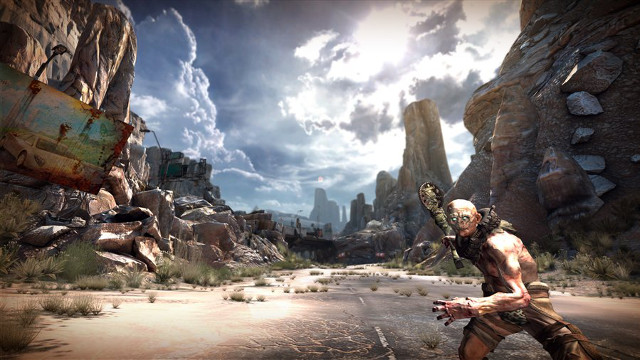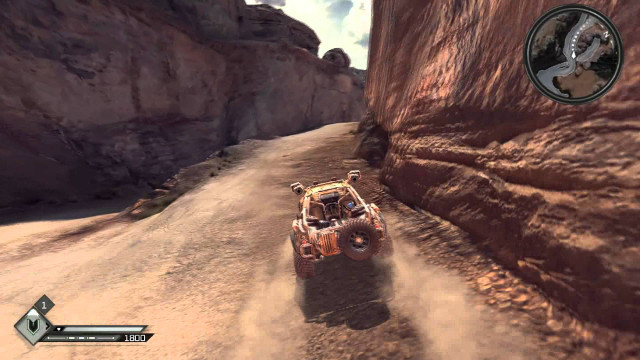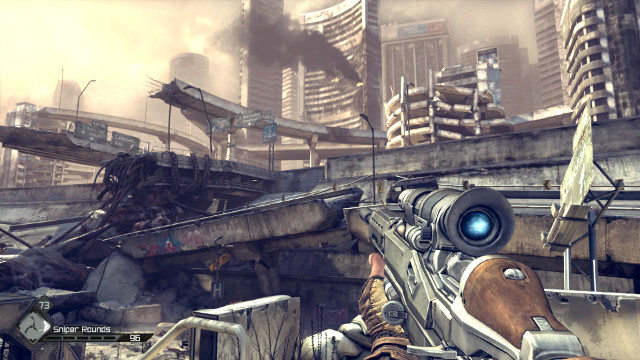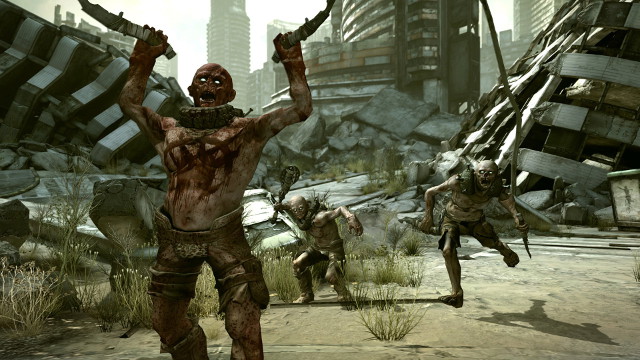With 2011’s Rage, id Software served up a unique cocktail — one part first-person shooter, one part role-playing game, and one part vehicular combat game — a compelling hybrid that ultimately fell short in its delivery.
After a recent play-through, I knew I loved the ideas at Rage‘s core, but I felt as though I had played through three incomplete games rather than the cohesive thrill-ride the game could have been.
At this year’s E3, Bethesda announced Rage 2, a collaboration between id Software and Avalanche Studios (scheduled for release in the first half of 2019).
This joint development is a chance for Rage‘s missteps to be corrected, and, with a bit of attention to its foundation, I am confident that these two studios will make the sequel something exceptional.
Here is how they could do it.

A More Seamless, More Explorable World
While Rage is technically an open-world game, its world is rather limited.
There is an over-world here (the Wasteland) that players can freely move through to reach the enclosed levels where a majority of missions are housed. However, the Wasteland feels very small. So small, in fact, that you never need to access a full map to locate yourself or your objectives.
This is fortunate because the game does not actually provide a full map to reference. As a result, navigating the Wasteland is primarily relegated to moving from one objective to the next, as those are demarcated on your mini-map.
Perhaps id did not include a full map in order to obscure exactly how small Rage‘s map is, but its exclusion is certainly not conducive to exploration.
That said, I do not necessarily believe the size of the Wasteland is a major failure, though an increase in size would be nice if the larger Wasteland was adequately populated. However, the hard distinction between being in the over-world and in the levels should certainly be eliminated in the sequel.
Seamlessly transitioning between the interstitial spaces and those where the missions are located would make the world feel big and alive, and allowing players to access a full map would let them choose how to explore it.
Additionally, a more subtle blending of these boundaries could allow players to use their vehicles in portions of the mission-focused areas — something that is not done in Rage. If vehicles are to be a critical element of the game, they must be useable for more than moving between missions in Rage 2.

Show Vehicles Some Love
On the topic of vehicles, Rage postures that their customization, combat, and utility are as important as the game’s gunplay, but that simply does not feel true. Every time you sit behind the wheel, it feels like an opportunity squandered.
These should be high-speed, adrenaline-pumping moments with the punk-rock attitude of Mad Max: Fury Road. Instead, vehicular combat in the Wasteland is lackluster, and the races and mini-games are a bore.
Playing on PC accentuates these problems, as the vehicular controls on mouse and keyboard leave something to be desired. This is a rare occasion where a first-person shooter may handle better with a controller.
These aspects are the perfect opportunity for Avalanche Studios to shine. While their 2015 action-adventure Mad Max received lukewarm reviews, its take on vehicles stands out, providing fast and furious gameplay and deep customization.
Simply transplanting this system to Rage 2 would be sufficient, but if Avalanche has more to offer, it might be magic.
Doubling-Down on RPG Elements
Rage is filled with elements that are very familiar to fans of modern RPGs: cities filled with NPCs to interact with, a quest log that keeps track of multiple objectives simultaneously, and a gear system that requires players to purchase their new weapons and modifications. It even has its own card game.
However, the developers stopped short by not including one crucial element: character progression that is not gear-based.
I would love to see skill trees that allow specialization in gunplay, engineering, and vehicles make an appearance in Rage 2.
While adding skill trees may put Rage a little too close to Bethesda’s newest Fallout entries, I believe, with a robust vehicle system and exhilarating corridor shooter gameplay, it would feel distinct enough to really benefit from the added depth to character progression.
Additionally, an increased focus on the game’s RPG-esque side quests would be appreciated. To start, demarcating the NPCs that actually have non-story missions for you would be a huge improvement – again, this is not done in Rage.
However, for the side-quests to really shine, Rage 2 needs to locate them in unique locations — simply, too much of the optional content in Rage takes you back to places you have already visited for story missions.

Widen the Rails
One of Rage‘s biggest failures is the design of its levels, which play out extremely linearly.
While the standard for FPS level design has certainly increased dramatically since Rage‘s release, moving through the game’s prisons and hideouts feels like a big step back from games released years prior. I am looking at you, Half-Life 2.
Often it is as though you are walking straight down a hallway, and it is rare to be able to jump on or over a set piece. The game asks you to shoot and keep moving forward until it eventually spits you back out into the Wasteland.
At least there is always a shortcut that, upon completing the level’s mission, takes you straight back to the level’s beginning, as needing to backtrack through these undeviating stages would be a painful undertaking.
Since Rage, id has shown us that they can knock corridor shooters out of the park with 2016’s Doom. If Rage 2 can find this delicate balance of on-the-rail spaciousness, it is certain to be a success.
Give Us More
In general, Rage feels stingy.
As stated, I find myself continually asking for more from almost every aspect of the game (its map, vehicles, and mechanics), and my last request is no different: more diversity.
To begin, Rage‘s barren over-world needs to be enriched for the sequel. While I certainly appreciate the game’s commitment to the post-apocalyptic world it inhabits, the entirety of the over-world need not be sandy desolation. Make the map’s regions distinct, and a world worth exploring will follow behind.
Further, the mission locations need some definition. There is usually a superficial distinction between the areas, but a bandit camp often feels fundamentally identical to a power plant. There are some exceptions — the Dead City and Jackal Canyon in particular — but that needs to be the standard in Rage 2.
Finally, more unique enemies. Please.
With “mutants” as an enemy type, there is no excuse for anything but a slew of off-the-wall and exciting opponents to slay, and I expect nothing less from the next installment.

Despite all of these issues, Rage‘s foundation is an extremely solid staring point. With a bit of embellishment and elaboration, I know that id and Avalanche can deliver an experience that will put Rage 2 in 2019’s conversation for Game of the Year.






Published: Oct 19, 2018 05:28 pm